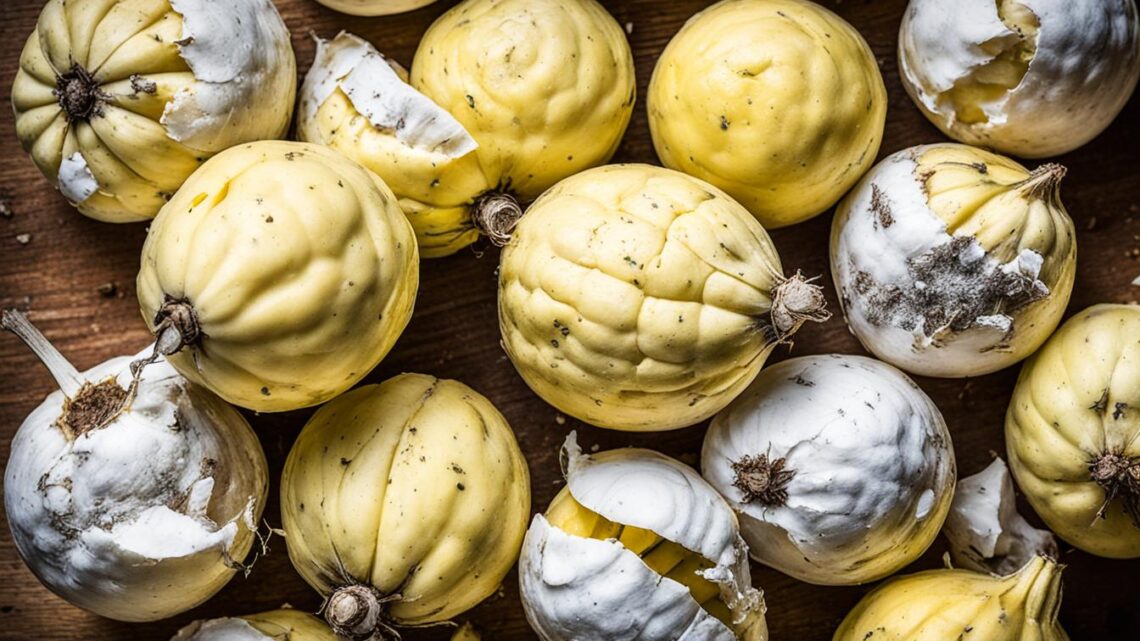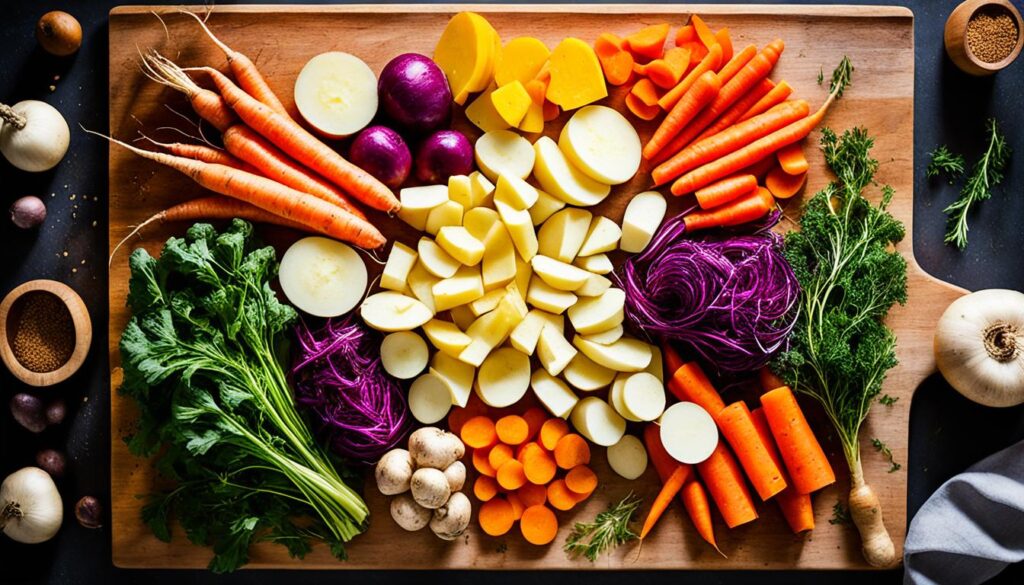
Have you ever thought about the unsung hero of root vegetables? The swede is this hero, a humble yet versatile veggie that should be in your kitchen. It’s often mixed up with turnips, but the swede has its own special taste and health benefits. Let’s dive into the swede’s history, cultural importance, and how it can make your meals better. We’ll see why the swede should be your go-to winter veggie.
What is a Swede?
Definition and Origins of the Swede
A swede, also known as a rutabaga, is a root vegetable. It belongs to the Brassica family, which includes broccoli, cauliflower, and cabbage. Swedes come from Scandinavia or Russia, with the first mention in 1620 in Switzerland.
The name «swede» comes from the Swedish word «rotabagge,» meaning «root bunch.» They are round with purple-green skin and creamy yellow flesh. Their sweet, earthy taste is different from turnips.
Swedes are bigger and longer than white turnips, which are smaller and round. They are sweeter and give more yield per plant, making them popular in Scotland. Swedes can handle frost well, thanks to their origins in cold Scandinavia.
| Characteristic | Swede | White Turnip |
|---|---|---|
| Size and Shape | Larger and longer | Smaller and more round |
| Flavor | Sweeter | Less sweet |
| Yield | Higher | Lower |
| Maintenance | Low, hardy in cold | Higher, more fertilizer needed |
Swedes, also known as Swedish turnips, are a versatile root vegetable. They have a long history in Scandinavian and Eastern European cooking. Their unique taste and nutrients make them great for any diet. They grow well in cool, temperate climates.

Swedes: Nutritional Powerhouses
Swedes, or rutabagas, are more than just a humble root vegetable. They are nutritional superstars. They have lots of vitamins, minerals, and plant compounds that are good for your health. These make them a key part of a balanced diet.
Swedes are full of vitamin C. Eating one cup of cooked swedes gives you over 50% of the daily vitamin C you need. This vitamin helps prevent cancer and keeps your immune system strong. Swedes also have vitamins E, K, and B6, and minerals like manganese, potassium, magnesium, calcium, iron, and zinc.
Swedes have plant compounds like carotenoids and glucosinolates. These antioxidants help fight off diseases and support health. They also have a lot of fiber, which helps with weight control and supports bone health.
Adding swedes to your meals is a great way to improve your health. You can roast, mash, or add them to soups and stews. They are tasty and can be part of any meal.

Cooking with Swedes
Versatile Preparation Methods
Swedes are a versatile root vegetable that can be prepared in many tasty ways. Start by peeling, trimming, and cutting the swede into small pieces. Then, you can boil, steam, roast, or stir-fry them.
To boil, put the swede pieces in salted water and cook for 12-15 minutes until they’re tender. Steaming is quick and easy, taking only 10-15 minutes. Roasting at 400°F (200°C) for 40-55 minutes gives a caramelized, sweet taste.
After cooking, you can mash swedes, add them to soups and stews, or use them as potato substitutes in dishes like shepherd’s pie. Grating raw swedes is also a great way to enjoy their crunchy texture in salads and slaws.
Swedes are versatile and nutritious, no matter how you prepare them. Try different cooking methods and flavors to find your favorite way to enjoy this root veggie.
| Preparation Method | Time | Technique |
|---|---|---|
| Boiling | 12-15 minutes | Place swede chunks in salted water and cook until tender |
| Steaming | 10-15 minutes | Steam swede chunks until tender |
| Roasting | 40-55 minutes | Roast swede chunks at 400°F (200°C) until caramelized |
| Stir-fry | 5-10 minutes | Sauté diced swede with other vegetables and seasonings |
| Mashing | N/A | Mash cooked swede chunks with butter, milk, and seasonings |
Swedes can also be grated raw and added to salads or slaws for a crunchy texture and mild flavor.

Swede Dishes Around the World
Swedes may not be as well-known as other root veggies. But they are a favorite in many international recipes worldwide. They go from the rich mashed swedes of Scandinavia to the tasty swedes in British food. This versatile veggie has left its mark on food traditions everywhere.
In Scandinavian cuisine, swedes get mashed with potatoes and butter to make «rotmos» or «kålrabistappe.» These creamy dishes are a key side dish in the area. They go well with many meats and seafood.
Across the British Isles, swedes (or «neeps») are a must with haggis. They also add flavor and texture to Cornish pasties and Branston Pickle.
In Canada and Newfoundland, swedes are part of the hearty «Jiggs dinner.» In Australia and New Zealand, they’re used to spice up stews, casseroles, and soups.
Though not as common in American cuisine, swedes still show up in New England boiled dinners and Midwest pasties. They bring a unique taste to these local dishes.
Swedes are a versatile ingredient worldwide. They add flavor and nutrition to many dishes.
| Cuisine | Swede Dishes |
|---|---|
| Scandinavian | Rotmos (Mashed Swedes and Potatoes), Kålrabistappe |
| British | Neeps (Boiled Swedes), Cornish Pasties, Branston Pickle |
| Canadian/Newfoundlander | Jiggs Dinner |
| Australian/New Zealand | Swede-based Stews, Casseroles, and Soups |
| American | New England Boiled Dinners, Midwest Pasties |
Selecting and Storing Swedes
Swedes are a tasty root vegetable that should be in your kitchen. When picking the best swedes, remember a few important tips.
Look for medium-sized swedes with smooth, clean skin. Stay away from soft, wrinkled, or colored ones. They might taste bitter. Swedes are best from mid-October to late February. This is when they are freshest and taste the best.
Tips for Keeping Swedes Fresh
To keep your swedes fresh, wrap them in a damp towel and put them in the fridge for up to 10 days. If you want to store them for longer, you can freeze them. Peel, dice, and blanch the swedes for 3 minutes. Then, spread them on a baking sheet to freeze. Once frozen, put the cubes in an airtight container. Swedes can stay tasty for several months if stored right.
| Storage Method | Shelf Life |
|---|---|
| Refrigerator (wrapped in damp towel) | Up to 10 days |
| Frozen (peeled, diced, and blanched) | Several months |
With these easy tips, you can enjoy swedes all season. Roast them, mash them, or add them to your favorite dishes. They taste great and are versatile.
Surprising Health Benefits of Swedes
Swedes, also known as rutabagas, are more than just tasty. They are full of nutrients that help fight cancer by slowing down tumor growth. They have lots of vitamin C, antioxidants, and compounds that help prevent cancer.
Swedes are great for people with diabetes or those trying to lose weight. They are low in carbs but high in fiber. This makes them good for your gut and can help with constipation and better digestion.
Swedes are full of nutrients that boost your immune system, skin, bones, and heart health. Adding this root vegetable to your meals can help your whole body.
- Swedes are rich in vitamin C, an antioxidant that can help prevent cancer by reducing tumor growth.
- The low-carb, high-fiber nature of swedes makes them beneficial for managing diabetes and weight loss.
- Swedes contain compounds that can improve digestive health and relieve constipation.
- Swedes are a great source of nutrients that support immune function, skin health, bone strength, and cardiovascular wellness.
| Nutrient | Amount in 1 Medium Swede (386g) | % Daily Value |
|---|---|---|
| Vitamin C | 107 mg | 107% |
| Potassium | 1,180 mg | 35% |
| Dietary Fiber | 9 g | 24% (men), 36% (women) |
Adding swedes to your meals can bring many health benefits. These include fighting cancer, improving digestion, and boosting heart health. This root vegetable is a must-have in your kitchen.
Seasonal Availability and Varieties
Swedes, also known as rutabagas, grow best in cool weather. They are in season from mid-October to late February in the Northern Hemisphere. This makes them a great choice for winter meals.
There are many swede cultivars to pick from. Some popular ones are ‘American Purple Top’, ‘Laurentian’, and ‘Wilhelmsburger’. Each type might be a bit different in size, color, and taste. But they all have a sweet, earthy flavor that people love.
You can find swedes at farmer’s markets or in the grocery store. They are a seasonal treat that should be in your winter cooking. You can roast, mash, or use them in many dishes to enjoy their unique taste.
| Swede Variety | Characteristics |
|---|---|
| American Purple Top | A classic swede variety with a purple-tinged top and yellow flesh, known for its sweet, earthy flavor. |
| Laurentian | A smooth, globe-shaped swede with a purple-green exterior and yellow interior, prized for its excellent storage capabilities. |
| Wilhelmsburger | A large, round swede with a distinctive purple-tinged skin and a creamy, mild-flavored flesh. |
Choosing any swede varieties will add something special to your meals in autumn and winter. Embrace the season and try new ways to use swedes in your cooking.
Swede Recipes to Try
Swedes are a versatile root vegetable that can be used in many tasty dishes. They have an average star rating of 4.3 out of 5. This shows they are a hit with many people.
Try a swede soup or stew for a warm, flavorful meal. Swedes mix well with spices and other veggies. They also work great as a side dish, especially with meat or poultry.
Swedes can be the main attraction, like in a swede casserole. This dish combines swedes with potatoes, parsnips, and a creamy sauce. Or, add shredded swedes to a swede salad for a fresh twist.



